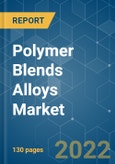The market for polymer blends alloys is expected to grow at a CAGR of more than 5.3% globally during the forecast period. Alloy is a metal that consists of combining two or more different elements mostly different metals. Polymer blends belong to a material class analogous to metal alloys, in which two polymers are mixed to create a new material with different physical properties. The growing demand from the electronics industry has been driving the market growth.
Key Highlights
- However, the high costs involved in processing and manufacturing of polymer blends alloys and the outbreak of coronavirus across the globe are likely to hinder the growth of the studied market.
- The rising penetration of polymer blends alloys in the consumer goods is likely to provide opportunities for the studied market, during the forecast period.
- Asia-Pacific region dominated across the world with increasing consumption from countries like China and India.
Key Market Trends
Automotive Segment to Dominate the Market
- The automotive segment stands to be the dominating segment owing to the continuous development of better and more advanced polymer blend alloys, coupled with the growing popularity of electric vehicles.
- Polymer blends alloys offer well-balanced mechanical, electrical, and thermal properties and also have a relatively lower density than other engineering polymers, enabling polymer blend alloys to provide automotive vehicles with compactness, superior performance, and flammability.
- Increasing demand for lightweight and thermally stable products in the automotive industry is largely responsible for the development of the market for polymer blends alloys, to provide improved production performance and versatility.
- Since 2018, in countries such as the United States, China, and Germany, the automotive industry has experienced a decline in production because of which consumption of polymer blends alloys is expected to decline. Nonetheless, from 2021 the automotive industry is expected to see a turnaround in production.
- Throughout the forecast timeframe all the above conditions are anticipated to boost the demand for polymer blends alloys.
Asia-Pacific Region to Dominate the Market
- Asia-Pacific has seen substantial growth in the demand for polymer blends alloys in the recent past, especially from countries such as China, South Korea, and India.
- In terms of scale, the Asia-Pacific region's electronics industry is the largest. Owing to the use of advanced technologies, a growing number of R&D centers, and rising customer demand, the market for polymer blends alloys is expected to rise over the forecast period.
- Smartphones, tablets, portable speakers, and AI-assisted electronics are witnessing a high growth rate in the region. Other industrial segments and sectors are also expected to impact the growth of the market.
- In Asia-Pacific, the China Government is offering major financial and non-financial incentives to boost electric car purchases. New Energy Vehicle (NEV) program of the country aims to help the electrics cross 20 percent of the automobile industry by 2025. The NEV market, however, is expected to expand exponentially by the end of 2020, after the subsidies have been terminated.
- Thus, positive growth is expected to drive the titanium alloy market throughout the forecast period. Overall, the Asia-Pacific region is expected to register a high CAGR over the forecast period.
Competitive Landscape
The global polymer blends alloys market is partially fragmented in nature. Some of the major companies are SABIC, CHIMEI, LyondellBasell, Mitsubishi Engineering-Plastics Corporation, and Daicel Polymer Ltd. amongst others.
Additional Benefits:
- The market estimate (ME) sheet in Excel format
- 3 months of analyst support
This product will be delivered within 2 business days.
Table of Contents
Companies Mentioned (Partial List)
A selection of companies mentioned in this report includes, but is not limited to:
- Arkema
- BASF SE
- Chi Mei Corporation
- Covestro AG
- Daicel Polymer Ltd.
- Donna Polymer
- JSR Corporation.
- Mitsubishi Engineering-Plastics Corporation
- Ovation Polymers Inc.
- SABIC
- LyondellBasell
Methodology

LOADING...








